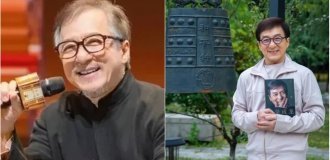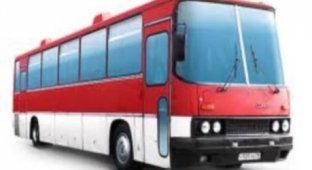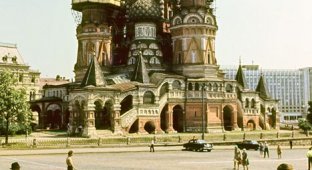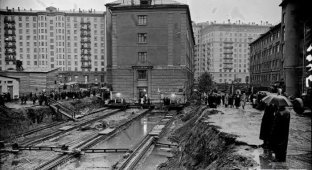IKARUS buses - an excursion into the past (53 photos)
Many of us remember the times of the Soviet Union and the yellow and red-white Ikarus buses plying the city streets. Now there are almost no buses of the same 200 series left, and the new ones no longer attract attention. I offer you a selection of photographs of rare buses built on the basis of the 200 series, some did not reach either the USSR or Russia, and some were produced in single copies.

Ikarus 250 Prototype (1967)


The first prototype of the Ikarus 250 intercity bus (and, in fact, the entire series) was assembled in 1967. As with previous models, the Ikarus 250 has undergone the most rigorous testing. One of the first copies in 1968 underwent operational tests in the USSR, including with the participation of leading institutes such as NAMI and NIIAT. Interestingly, this bus had rectangular headlights, while the production Ikarus 250 will receive four round headlights. Ikarus 242 (1969-1970)


Low-floor bus Ikarus 242. The first presentation took place at the 1969 trade fair in Leipzig, where the bus was awarded a gold medal. It began the development of a special low-floor Ikarus series: 240, 242, 284. In the period from 1969 to 1970, several prototypes were made, but the model did not go into series. One of the peculiarities of the 242 model is its unusual coloring: the first door and the “shield” in front were painted in a different color. It existed in two variations: urban and suburban, in addition there was a modification 240, characterized by a reduced length of 720 mm. Ikarus-Scania 664 (1972)

Ikarus 255 Omnibus für Kinder (1972)


A special version of Ikarus 255.74, designed for transporting children. The bus has a seven-row seating layout (104 seats for children and 5 for accompanying adults). Ikarus 266 (1973)

Ikarus 266 differed from the 260 model in its rear-engine layout and the presence of two doors. It was produced in two variations: suburban and urban (number of seats 45 and 30, respectively). In November 1974, the Leningrad branch of NIIAT began autumn-winter tests of the Ikarus 266 on route 431 Leningrad-Gatchina, since deliveries of buses of this type were planned to Leningrad. This was later abandoned. Ikarus 190 (1973–1977)


Initially, this bus was developed specifically for Germany, where the union of motor transport enterprises made recommendations for bus manufacturers on what kind of buses they needed (VOV standard). The recommendations also concerned appearance, which explains the similarity of German cars even of different brands. 154 copies were exported to Germany (Hamburg), 100 to Kuwait, and only 2 remained in Hungary. Ikarus 280 Suburban (1973-2000)


Ikarus 254 (1975)

Ikarus 260 CH (1975)

Created specifically for Switzerland. The "CH" index is the identification mark of Swiss vehicles in international traffic. Features include: special “northern” glazing, high-power heaters, Webasto heater with a 24-hour timer, wide doors. Particular attention is paid to safety measures, for example, when you start driving with the doors open, the brake system is automatically activated. Designed for intercity communication. Ikarus 270 (1975)

It was first shown in 1975 at the international autumn fair in Budapest. It was intended for intercity communication. The salon accommodates 40 chairs, a buffet, a refrigerator, a washstand, and a wardrobe. Comfortable, adjustable seats are equipped with seat belts. The 12 m long vehicle weighs 11.2 tons when loaded, and 16 tons when fully loaded. A six-cylinder diesel engine with a power of 220 hp, located in the rear of the vehicle under the cabin floor, allows the bus to reach a speed of 106 km/h. The stepped body shape is explained by the fact that the cabin floor is raised more than usual (200 mm higher in relation to the driver's compartment) to provide space for capacious luggage compartments. Simultaneously
However, it was possible to significantly increase the safety of passengers by raising them above the area where the sidewalls of the body are most likely to be damaged in an accident. The rear superstructure is caused by the need to accommodate the air conditioning unit and its air intake grille. Other features of this model include independent front suspension, separate pneumatic brake drive, five-speed transmission, hydraulic power steering, and a safe steering column. Ikarus 222 (1975–1979)

Ikarus 212 LUX (1976)

Ikarus-MAN 212 (1976)


Ikarus-MAN 662 (1976–1977)

Ikarus-MAN 272 (1978)

Ikarus 281 (1978)


Version of the city model 280 for left-hand traffic. In white and red livery, 124 buses were delivered to Mozambique in 1978-80. Ikarus 282 (1978–1980)

It is a model 280 extended by 1.5 meters. The length of the trailer has been increased by one window section. From 1978 to 1980, 10 buses were built. Ikarus 284

Ikarus 286 Crown (1978-1984)


Version for the US market. Screwdriver assembly was carried out in Union City, Indiana in the 1980s. Worked in bus fleets in cities such as Portland, Houston, Milwaukee, Louisville, San Mateo, Honolulu, Jacksonville, Albany, Santa Clara. Ikarus 258 (1983)

Ikarus 263/283 (1985–1998)


The Ikarus 263 and 283, produced from the mid-1980s, were extensions of the Ikarus 260 and 280 by 1 m. These buses were developed for export to the GDR, and later production began for use in Hungary. Externally they differed in small additional windows behind the front and rear doors. The first buses were equipped with two four-leaf doors. They used the same D2156 HM6U turbocharged diesel engine with 220 hp. Increasing the length of the bus made it possible to change the interior layout. Instead of the removed seats, a spacious storage area appeared opposite the middle door. The rear storage area was also enlarged. The cabin has become much more comfortable due to the installation of new seats with higher backs and side handles for standing passengers. The seats located near the doors were separated from them by glass partitions. The new type of lighting lamps used fluorescent lamps. A year later, these innovations were introduced on the Ikarus 260 and 280. Ikarus 216 (1985–1990)

Middle class commuter bus. Exported to Kuwait (from 1989 to 1990). Equipped with an automatic transmission and air conditioning. The bus windows are tinted, and the body is painted in a traditional Kuwaiti coloring. Ikarus 284T (1988)

Built in a single copy based on the Ikarus 284 city bus with a low floor level. Was presented to the public at a trade fair in Budapest. Equipped with electrical equipment from the Hungarian company GANZ. The power of the GANZ HXUR/E 56 5G2 B20 electric motor is 170 kW, rated voltage is 600 V. The engine was located at the rear of the trailer, behind the third axle. The second and third axles had gable tires, the drive was carried out on the last axle. The trolleybus has three inward-opening planetary-type double doors, which could also be opened from the outside using a button.
Ikarus 293 (1988)


In 1988, Ikarus built a multi-section bus based on the Ikarus 293 bus, 22.5 meters long. The prototype passed all the required tests and visited exhibitions. But drivers complained about very difficult handling and the matter never came to the point of transporting passengers. The project was frozen until 1992. Then, on the same bus, the engine, interior and paint were replaced. After this, several more such buses were sold to Iran. A licensed copy of the bus was also built under ma
strong Giron for Cuba.
Ikarus 290 (1988)


Ikarus 290 is designed to transport passengers at airports. The engine, D2156 HM6U, was moved to the front of the bus, which made it possible to organize a low-floor interior layout. The production of the bus was intended for export. One bus each was sold to the Middle East and Czechoslovakia, and India and Mozambique received 4 each.
Ikarus-Steyr 259 (1991)

Ikarus-Scania 259


Ikarus 692 PALT


Ikarus 250SL




Ikarus 200

The exotic convertible is based on the 250 model. Used for excursions to European cities. Modernized several times.


"Classic" series: C50, C56, C60, C63, C80, C83 (1998–2004)




Buses of the "C" series are the result of the modernization of the 200th series (received the index "C" instead of "2" in the designation). The main body design has changed.



























